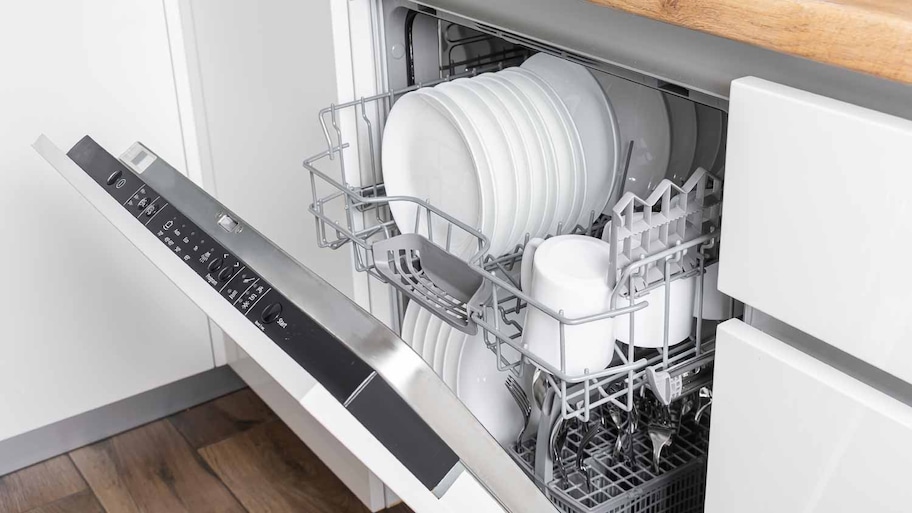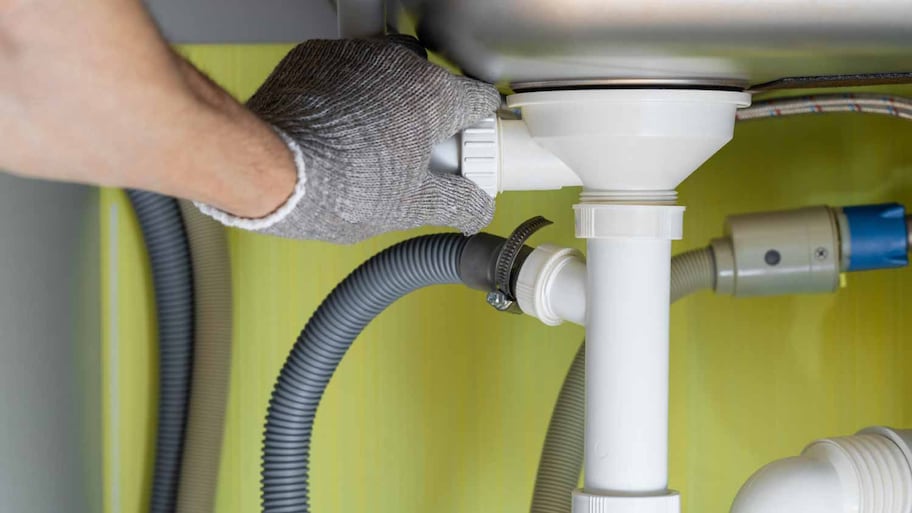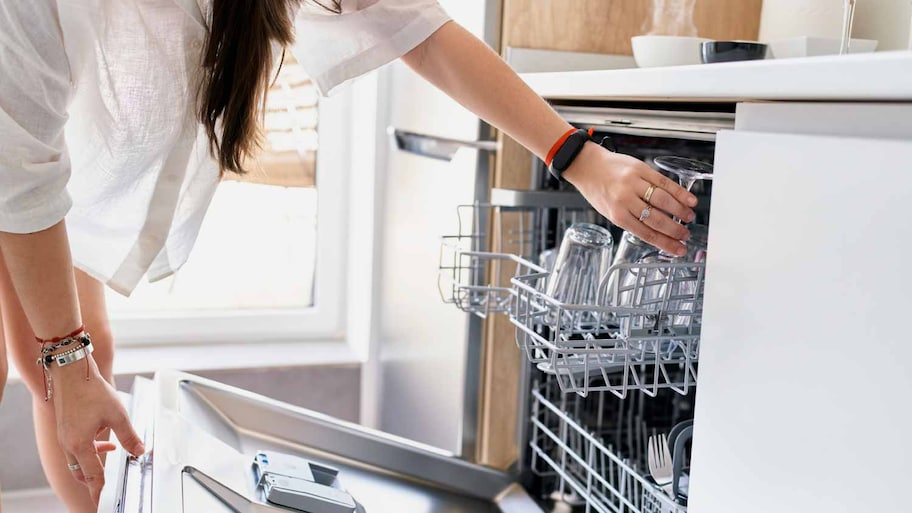How to Clean a Dishwasher Drain: 7 Effective Methods
Gear up for sparkling clean dishes with each cycle


A clean dishwasher drain is a must to keep your appliance running smoothly. Over time, food particles, grease, and soap scum can accumulate in the drain, leading to unpleasant odors, slow drainage, and even clogs. Regularly cleaning the dishwasher drain tackles these issues, prolongs your dishwasher's life span, and prevents costly repairs. Learn how to clean a dishwasher drain to keep the clean water flowing.
Why Do I Have to Clean My Dishwasher Drain?
Cleaning your dishwasher drain is crucial for maintaining its efficiency and longevity. A clogged or dirty drain can prevent the dishwasher from properly removing waste and water, leading to standing water and dishes that don't get washed well.
The debris buildup can also create a breeding ground for mold and bacteria, causing foul smells and potential health hazards. If your dishwasher is not cleaning well, you could be eating and drinking from soiled dishes. Regularly cleaning the drain provides you with consistently sanitized dishes.
A persistently clogged dishwasher drain can also cause water to back up into the dishwasher or sink, potentially causing leaks that can damage your kitchen flooring and cabinetry. Finally, overworked drains can put undue stress on the dishwasher's pump and motor, potentially leading to mechanical failures that require expensive repairs or replacement.
How Much Does It Cost to Clean a Dishwasher Drain?
Professional drain cleaning costs about $240 on average, though it ranges from $150 to $345. DIY cleaning a dishwasher drain using at-home methods costs less than $20 for supplies. However, if it's a deep clean that you're not sure you can tackle on your own, you’ll need to hire a local dishwasher repair technician to do the job for you.
Signs You Need to Clean Your Dishwasher Drain
Several signs may indicate your dishwasher drain requires cleaning.
Clogged Filters: Visible debris or buildup in the dishwasher filter.
Dirty Dishes: Dishes remain dirty or have residue after a complete cycle.
Frequent Clogs: Recurrent issues with water not draining properly.
Gurgling Noises: Unusual gurgling sounds during the draining process.
Leaking Water: Water leaks around the dishwasher door or underneath it.
Slow Drainage: Water pools at the bottom of the dishwasher or drains slowly.
Standing Water: Persistent standing water at the bottom of the dishwasher after a cycle.
Unpleasant Odors: Foul smells coming from the dishwasher.
Visible Debris: Food particles or debris accumulating around the drain area.
Water Backups: Water backs up into the sink when the dishwasher runs.
How to Clean a Dishwasher Drain

There are a few methods you can try to clean out your dishwater drain. Simple solutions like a non-invasive clean may do the trick but more buildup would require a deeper clean. For each cleaning method, run a small cycle on the dishwasher after you’re done to ensure everything is running well.
1. Manually Clean the Drain
Start by removing the bottom rack to access the drain area. Clear any visible debris or food particles from around the drain. If your dishwasher has a drain screen or filter, carefully take it out and wash it with warm, soapy water to remove any buildup. Once cleaned, reassemble the filter or screen back in its place. You can also use a damp cloth to wipe down the area around the drain to ensure no residue is left behind. Replace the bottom rack.
2. Clean with Baking Soda and Vinegar
Sprinkle one cup of baking soda around the drain area at the bottom of the dishwasher. Next, pour one cup of white vinegar around the drain area. Let the mixture sit for 15 to 20 minutes to allow the baking soda and vinegar to react and break down any grime, grease, and debris. Then run a hot water cycle to flush the solution through the drain to clean and deodorize it.
3. Clean With Hot Water and Dish Soap
Begin by boiling a pot of water. Add a few drops of mild dish soap directly into the dishwasher drain. Carefully pour the boiling water down the drain. The combination of hot water and dish soap breaks down stubborn residues and clears the drain. Let the solution sit for up to five minutes before running a hot water cycle in the dishwasher to rinse away any remaining residue.
4. Use a Drain Snake
Turn off and unplug the dishwasher and remove the bottom rack to access the drain area. If there's a filter or drain screen, remove it to expose the drain opening. Insert the drain snake into the drain, gently pushing and rotating it to navigate through the pipe and break up any clogs or debris. Continue feeding the snake into the drain until you encounter resistance, then pull it back out, bringing any dislodged debris with it. Repeat this process until the drain is clear. Afterward, reassemble the filter and bottom rack.
5. Clean the Air Gap
Locate the air gap, searching for a small cylindrical fixture mounted on the sink or countertop near the dishwasher. Remove the air gap cover by twisting it off or lifting it straight up. Inspect the inside for any visible debris or blockages and use a brush or a small, flexible tool to clear out any obstructions. Rinse the interior of the air gap thoroughly with water to ensure all debris is removed. After cleaning, reattach the cover securely.
6. Clear the Garbage Disposal
Turn off both the dishwasher and the garbage disposal. Locate the drain hose connected to the dishwasher under the sink. In most cases, the hose is attached to the garbage disposal or sink drain. Carefully disconnect the drain hose from the garbage disposal, using pliers if necessary. Check for any clogs or debris inside the disposal and remove them using a tool or by hand. Practice caution to avoid damaging the disposal blades. Once cleared, run water through the garbage disposal to ensure it's flowing freely. Reattach the drain hose securely to the garbage disposal and confirm there are no leaks.
7. Clean the Drain Hose
Turn off and unplug the dishwasher. Locate the drain hose found beneath the sink. The hose will be connected to either the garbage disposal or sink drain. Place a towel or bucket under the connection to catch any water, then carefully disconnect the hose using pliers, if necessary. Inspect the hose for any clogs or buildup and use a long, flexible brush or run water through the hose to clear any obstructions. After thoroughly cleaning the hose, reattach it securely to ensure no leaks are present.
How to Keep a Dishwasher Drain Cleaning Schedule

To keep the drain in good condition, set up a regular cleaning schedule based on how frequently you use your dishwasher and your pre-washing habits. For households that run the dishwasher daily and often load dishes without thoroughly scraping off food particles, aim for a monthly drain cleaning. This frequency helps prevent the buildup of food debris and grease, which can lead to clogs and unpleasant odors. If your household only uses the dishwasher a few times a week and always rinses dishes before loading, cleaning every two to three months is fine.
You should also perform weekly checks to remove any visible food particles around the drain and clean the filter every two weeks.
DIY vs. Hiring a Pro
DIY cleaning of a dishwasher drain is a practical and cost-effective approach for most minor clogs and routine maintenance. For simple issues like slow drainage, unpleasant odors, or occasional standing water, DIY methods such as manually removing debris, using a baking soda and vinegar solution, or flushing the drain with hot water and dish soap works wonders.
But if you have persistent, severe drainage issues such as extensive standing water, repeated backups, or leaks around the dishwasher, it’s time to call a local dishwashing repair tech. These could be signs of bigger issues with various parts of your dishwasher, like a faulty pump. It could also signal severe plumbing problems or trouble with the garbage disposal. A professional who fixes dishwashers has specialized tools and expertise to diagnose and resolve these complex issues.
Frequently Asked Questions
While the exact appearance of the filter will depend on your dishwasher brand, it often consists of a cylindrical or rectangular mesh or plastic component. The filter is located at the bottom of the dishwasher beneath the lower spray arm. It includes a combination of a coarse filter, which traps larger food particles, and a finer filter, which captures smaller debris. The filter assembly may be a single unit or a multi-part system that can be twisted or snapped out for cleaning.
To clean an old dishwasher without a filter, start by removing the bottom rack to access the drain area. Use a damp cloth or sponge to wipe down the interior, paying special attention to the corners and crevices where food particles and debris can build up. Pour a cup of white vinegar into a dishwasher-safe bowl and place it on the top rack, then run a hot water cycle to help break down grease and grime. After the cycle, sprinkle a cup of baking soda across the bottom of the dishwasher and run a short hot water cycle to deodorize and further clean the interior.
A dishwasher filter should be replaced every five years, depending on the manufacturer's recommendations and the frequency of use. The exact timing can vary based on factors such as the hardness of your water, how well you rinse dishes before loading them, and how often you clean the filter. Regularly inspect the filter for signs of wear and tear or damage. If the filter appears worn out, damaged, or excessively clogged despite regular cleaning, it should be replaced sooner.
